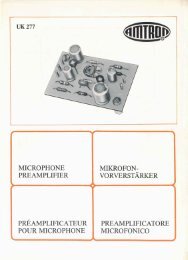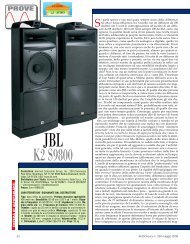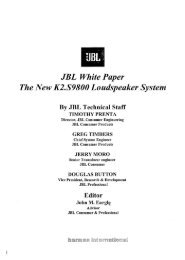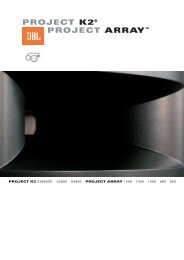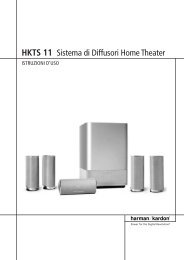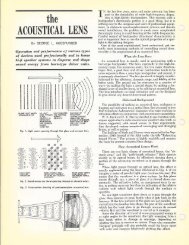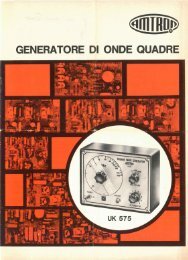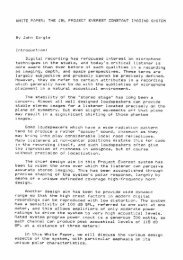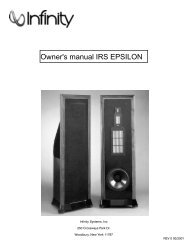MEASUREMENTS
MEASUREMENTS
MEASUREMENTS
Create successful ePaper yourself
Turn your PDF publications into a flip-book with our unique Google optimized e-Paper software.
GLOSSARY OF TELEVISION TERMS<br />
DC RESTORER A circuit used in picture monitors<br />
and waveform monitors to clamp one point of the<br />
waveform to a fixed DC level.<br />
DEMODULATOR In general, this term refers to<br />
any device which recovers the original signal after it<br />
has modulated a high frequency carrier. In television,<br />
it may refer to:<br />
(1) An instrument, such as a Tektronix 1450, which<br />
takes video in its transmitted form (modulated onto<br />
the picture carrier) and converts it to baseband.<br />
(2) The circuits that recover U and V from the<br />
composite signal.<br />
EQUALISER The pulses that occur before and after<br />
the broad pulses in the vertical interval.<br />
ENVELOPE DETECTION A demodulation process<br />
in which the shape of the RF envelope is sensed.<br />
This is the process used by a diode detector.<br />
FIELD In interlaced scan systems, the information for<br />
one picture is divided up into two fields. Each field<br />
contains half of the lines required to produce the entire<br />
picture. Adjacent lines in the picture are in alternate<br />
fields.<br />
FM Frequency Modulation (FM) is the process by<br />
which the frequency of a carrier signal is varied in<br />
proportion to the signal of interest. In the PAL television<br />
system, audio information is transmitted using FM.<br />
FRAME A frame (sometimes called a "picture")<br />
contains all the information required for a complete<br />
picture. For interlaced scan systems, there are two<br />
fields in a frame.<br />
FRONT PORCH The portion of the video signal<br />
between the end of active picture time and the<br />
leading edge of horizontal sync.<br />
GAMMA Since picture monitors have a non-linear<br />
relationship between the input voltage and brightness,<br />
the signal must be correspondingly predistorted.<br />
Gamma correction is always done at the source<br />
(camera) in television systems: the R, G and B<br />
signals are converted to R ] h, G ] h and B^t. Values<br />
for gamma range from 2.2 to 2.8.<br />
GENLOCK The process of locking both sync and<br />
burst of one signal to sync and burst of another,<br />
making the two signals completely synchronous.<br />
HARMONIC DISTORTION If a sine wave of a<br />
single frequency is put into a system, and harmonic<br />
content at multiples of that frequency appears at the<br />
output, there is harmonic distortion present in the<br />
system. Harmonic distortion is caused by nonlinearities<br />
in the system.<br />
HORIZONTAL BLANKING Horizontal blanking<br />
is the entire time between the end of the active picture<br />
time of one line and the beginning of active picture<br />
time of the next line. It extends from the start of front<br />
porch to the end of back porch.<br />
HORIZONTAL SYNC Horizontal sync is the<br />
-300 mV pulse occurring at the beginning of each<br />
line. This pulse tells the picture monitor to go back to<br />
the left side of the screen and trace another horizontal<br />
line of picture information.<br />
HUE Hue is the property of colour that allows us to<br />
distinguish between colours such as red, yellow,<br />
purple, etc.<br />
HUM Hum refers to the undesirable coupling of the<br />
50 Hz power sine wave into other electrical circuits.<br />
INTERCARRIER SOUND A method used to<br />
recover audio information in the PAL system. Sound is<br />
separated from video by beating the sound carrier<br />
against the video carrier, producing a 5.5 MHz IF<br />
that contains the sound information.<br />
ITS Insertion Test Signal. A test signal which is inserted<br />
in one line of the vertical interval to facilitate in-service<br />
testing.<br />
LINEAR DISTORTION Refers to distortions that<br />
are independent of signal amplitude.<br />
LUMINANCE The signal which represents brightness,<br />
or the amount of light in the picture. This is the only<br />
signal required for black and white pictures, and for<br />
colour systems it is obtained as a weighted sum<br />
(Y = 0.3R + 0.59G + 0.11B) of the R, G and B<br />
signals.<br />
MODULATED When referring to television test<br />
signals, this term implies that chrominance information<br />
is present. (For example, a modulated ramp has subcarrier<br />
on each step.)<br />
MODULATION A process which allows information<br />
to be moved around in the frequency domain in<br />
order to facilitate transmission or frequency-domain<br />
multiplexing. See AM and FM for details.<br />
72



